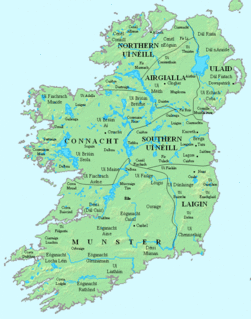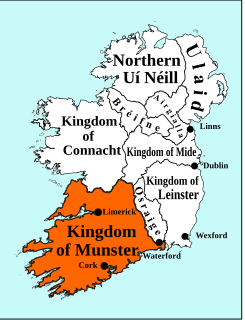In Irish mythology and genealogy, Aimend is the daughter of Óengus Bolg, king of the Dáirine or Corcu Loígde. She marries Conall Corc, founder of the Eóganachta dynasties, and through him is an ancestor of the "inner circle" septs of Eóganacht Chaisil, Eóganacht Glendamnach, and Eóganacht Áine, who established the powerful kingship of Cashel. Details of the story imply she may have originally been a goddess.

The Connachta are a group of medieval Irish dynasties who claimed descent from the legendary High King Conn Cétchathach. The modern western province of Connacht takes its name from them, although the territories of the Connachta also included at various times parts of southern and western Ulster and northern Leinster. Their traditional capital was Cruachan.

The Eóganachta or Eoghanachta were an Irish dynasty centred on Cashel which dominated southern Ireland from the 6/7th to the 10th centuries, and following that, in a restricted form, the Kingdom of Desmond, and its offshoot Carbery, to the late 16th century. By tradition the dynasty was founded by Conall Corc but named after his ancestor Éogan, the firstborn son of the semi-mythological 3rd-century king Ailill Aulom. This dynastic clan-name, for it was never in any sense a 'surname,' should more accurately be restricted to those branches of the royal house which descended from Conall Corc, who established Cashel as his royal seat in the late 5th century.
Cathal mac Finguine was an Irish King of Munster or Cashel, and effectively High King of Ireland as well. He belonged to the Eóganacht Glendamnach sept of the dominant Eóganachta kin-group whose members dominated Munster from the 7th century to the 10th. His father, uncle, grandfather, and great-grandfather had also been kings of Cashel, so too were his son and grandson.

The O'Donoghue of the Glens, Prince of Glenflesk, is the hereditary chieftain of his sept of the Kerry Eóganacht. In 1944, his father was one of the few Chiefs of the Name recognized by Edward MacLysaght, the first Chief Herald, as having a verifiable pedigree and entitled to use the title and receive courtesy recognition by the Irish State.
Feidlimid mac Óengusa (455-500), or Feidlimid Dub, was an Eoganachta King of Munster in the early 6th century. He was the son of Óengus mac Nad Froích, the first Christian king of Munster.
Fíngen mac Áedo Duib was a King of Munster from the Eóganacht Chaisil branch of the Eoganachta. He was the great-grandson of Feidlimid mac Óengusa, a previous king. He succeeded Amalgaid mac Éndai as king in 601.
Ólchobar mac Cináeda was King of Munster from 847 until his death. He may be the "king of the Irish" who sent an embassy to Frankish Emperor Charles the Bald announcing a series of victories over Vikings in Ireland in 848.

The Kingdom of Munster was a kingdom of Gaelic Ireland which existed in the south-west of the island from at least the 1st century BC until 1118. According to traditional Irish history found in the Annals of the Four Masters, the kingdom originated as the territory of the Clanna Dedad, an Érainn tribe of Irish Gaels. Some of the early kings were prominent in the Red Branch Cycle such as Cú Roí and Conaire Mór. For a few centuries they were competitors for the High Kingship or Ireland, but ultimately lost out to the Connachta, descendants of Conn Cétchathach. The kingdom had different borders and internal divisions at different times during its history.
Cathussach mac Eterscélai was a king of Munster from the Eóganacht Áine branch of the Eóganachta. He was the son of Eterscél mac Máele Umai, a previous king. His branch of the Eóganachta was situated in the south east of modern County Limerick at Cnoc Áine (Knockainy) near the monastery of Emly in County Tipperary.
Ólchobar mac Duib-Indrecht was a supposed King of Munster from the Eóganacht Áine branch of the Eóganachta. His last paternal ancestor to hold the throne was Cúán mac Amalgado, five generations previous. His great grandfather Uisnech had been the brother of another King Eterscél mac Máele Umai. According to a genealogical tract Uisneach was heir apparent to the Munster throne until slain by his brother through envy and hatred and then Eterscél assumed the kingship of Munster.
Eóganacht Chaisil were a branch of the Eóganachta, the ruling dynasty of Munster during the 5th-10th centuries. They took their name from Cashel which was the capital of the early Catholic kingdom of Munster. They were descended from Óengus mac Nad Froích, the first Christian King of Munster, through his son Feidlimid mac Óengusa.
Eóganacht Áine or Eóganacht Áine Cliach was a princely house of the Eóganachta, dynasty of Munster during the 5th–12th centuries. They took their name from the Hill of Áine near the present day village of Knockainy, County Limerick. This region of Cliú is centred on the barony of Smallcounty in eastern Limerick. The nearby village of Emly was the ecclesiastical center of Munster at the time.
Eóganacht Glendamnach were a branch of the Eóganachta, the ruling dynasty of Munster during the 5th-10th centuries. They took their name from Glendamnach. They were descended from Óengus mac Nad Froích, the first Christian King of Munster through his son Eochaid mac Óengusa and grandson Crimthann Srem mac Echado. Kings of Cashel and Munster from the Eóganacht Glendamnach were:
Eóganacht Airthir Cliach were a branch of the Eóganachta, the ruling dynasty of Munster during the 5th-10th centuries. They took their name from Cliú, a territory in eastern Co.Limerick and parts of Tipperary. Airthir meant east and their territory was in the eastern section of this territory in Tipperary County around Tipperary town. They were descended from Óengus mac Nad Froích, the first Christian King of Munster through his son Eochaid mac Óengusa and grandson Crimthann Dearcon mac Echado. Crimthann's mother Dearcon was a member of the Arada Cliach, a minor group in Cliú.
Eóganacht Raithlind or Uí Echach Muman are a branch of the Eóganachta, the ruling dynasty of Munster during the 5th-10th centuries. They took their name from Raithlinn or Raithleann described around the area of Bandon, in the same area. Archaeologists believe that Garranes Ringfort in Templemartin parish, near Bandon, County Cork may have been Rath Raithleann, the royal seat of the Éoganacht Raithleann. They are descended from Mac Cass, the son of Conall Corc, the first King of Cashel, through Mac Cass' son Echu.
Cenn Fáelad hua Mugthigirn was a King of Munster of the Eoganachta, the ruling dynasty of Munster. He ruled from 861-872. He was also abbot of Emly from 851-872, an important monastery in County Tipperary where he succeeded a previous King of Munster, Ólchobar mac Cináeda.
Coirpre Luachra mac Cuirc was the ancestor of the Eóganacht Locha Léin branch of the Eoganachta, the ruling dynasty of Munster. This branch was also called the Ui Caipre Luachra, named after him and became the rulers of Iarmuman. He was the son of Conall Corc mac Luigthig, founder of the Eoganachta kingdom of Cashel in Munster.

The House of Óengus is a proposed dynasty that may have ruled as Kings of the Picts, as well as overlords of the Kings of Dál Riata and possibly of all of northern Great Britain, for approximately a century from the 730s to the 830s AD. Their first ruler of Pictland was the great Óengus I of the Picts, who may be the figure carved into the St Andrews Sarcophagus pictured on the right.
The Ciannachta were a population group of early historic Ireland. They claimed descent from the legendary figure Tadc mac Céin. They first appear in historical sources in the 6th century, and were found in several parts of the island, including in Brega and Tír Eoghain. The Ciannachta groups were absorbed over time.





